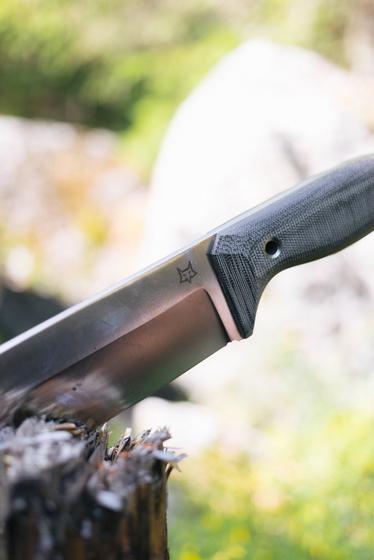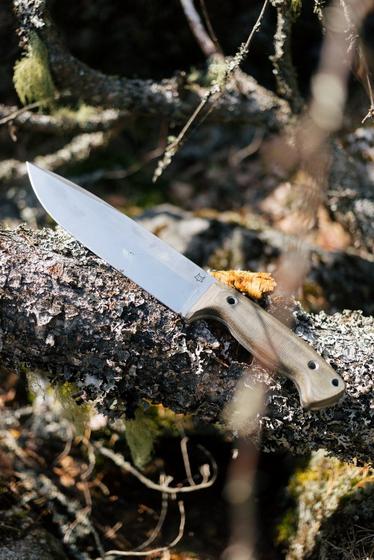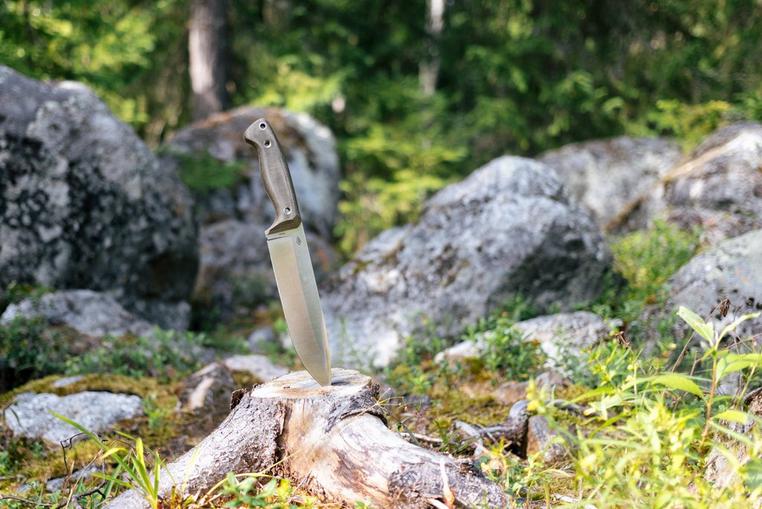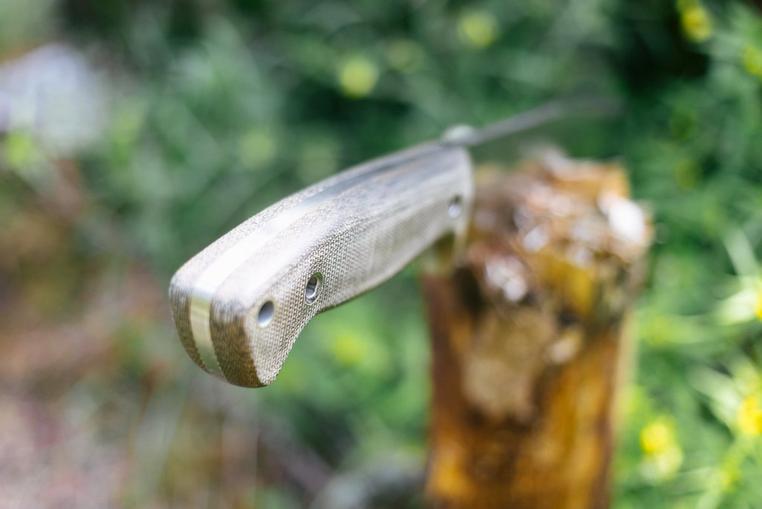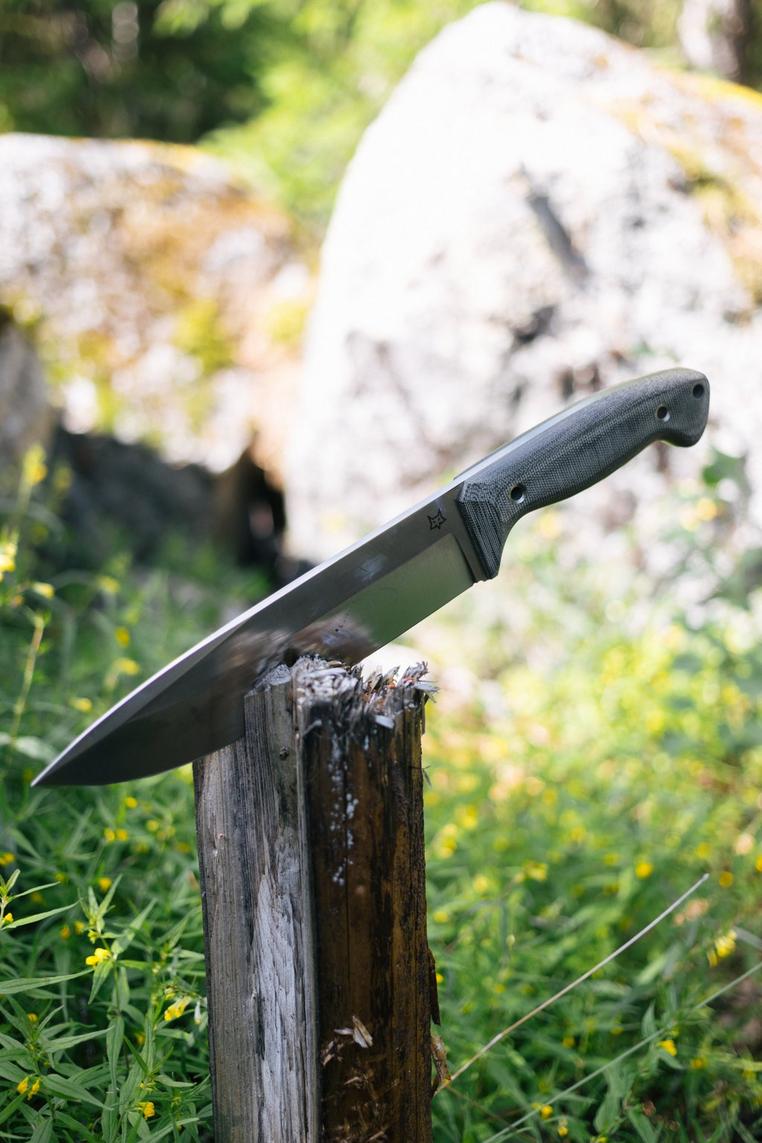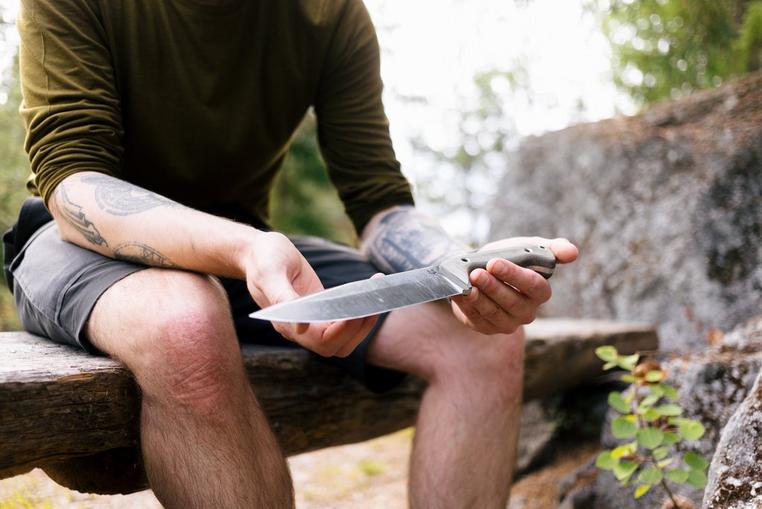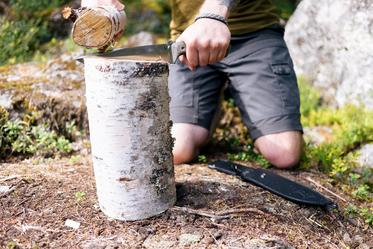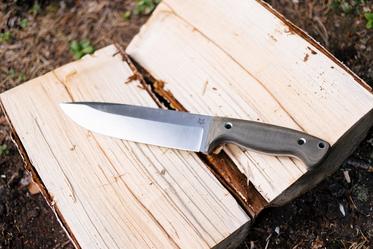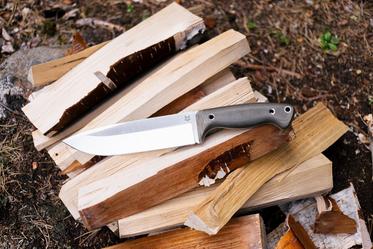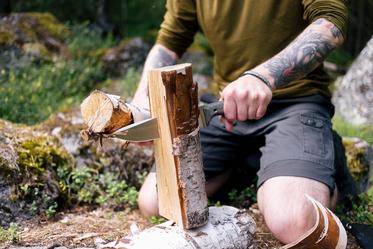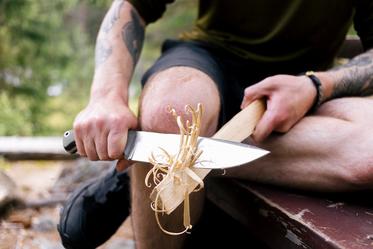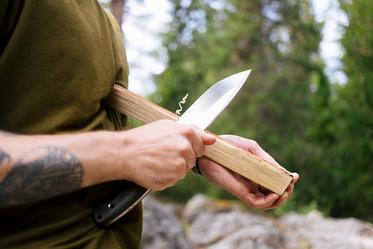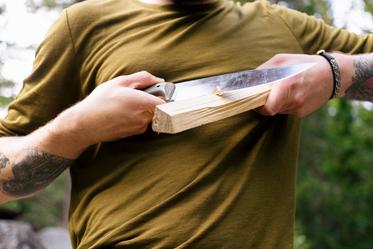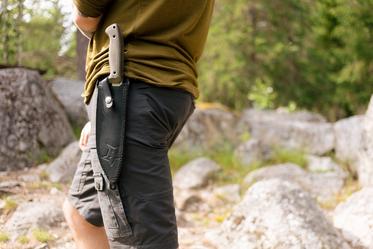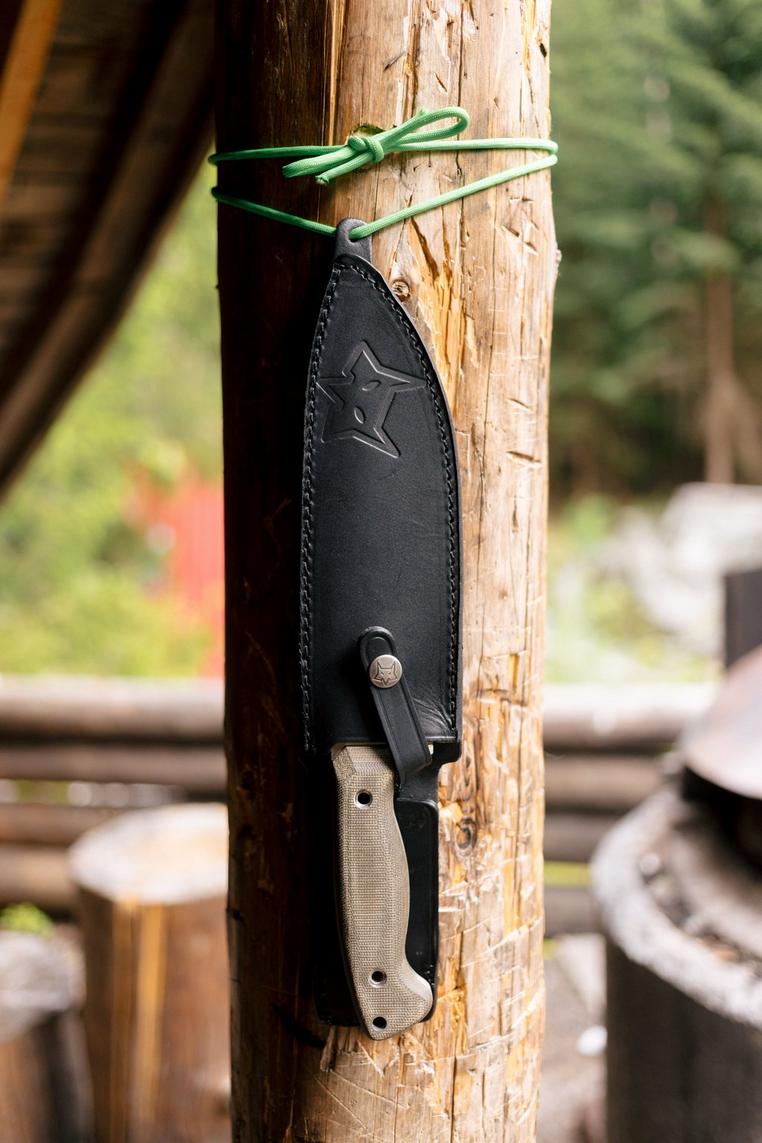Fox FX140 Kato Exclusive | Review by Padraig Croke
Your new basecamp workhorse
The Fox FX-140XL is a large camp knife that certainly lives up to its XL title. But with the availability of extremely capable belt knives more easily carried and used, where does a knife this size fit into your adventures? Aside from the obvious ‘survival’ tag that so many blades of this size get categorised into, I wanted to put this blade to test and see what it was capable of and where it might be best suited. I began to see this knife as more than just a personal carry, but perhaps a tool that would suit a larger basecamp situation.
Contents
The Camp Knife
They say you should never let another person use your knife. Your belt knife is your best friend in the outdoors, and comes with you everywhere you go when out in the backcountry! Hear me out on this, but the FX-140 is not the knife I would personally want to be wearing on my belt… although it is of course entirely possible, and for the sake of the review, I have tried it out. But herein lies a conversation I have not seen or heard spoken about much. It is widely accepted that if three or more people are planning on camping together, then it makes sense to communicate beforehand about who is bringing what. Typically one axe and one big saw are enough for a basecamp, alongside other camping equipment like kettles, cast iron cookware, a basecamp tarp… etc. So why not a camp knife as well? Perhaps there is an extremely obvious answer as to why not, and if there is I would love to hear about it.
In my book this is well and truly a basecamp knife. Much like the Lionsteel T6, which I reviewed last summer, I feel like the FX-140 should be the type of knife that is not held so preciously on the hip of its owner. A knife like this should be fit to be used around camp by everyone. An egalitarian tool that will suit most people's hands and exists to perform a task. With a knife like this, its sheer weight and size are, at least in my opinion, just too much tool for one person to justify walking around the woods with. That’s what your B40 is for. However! If a camp site doesn't have an axe on hand (which it should anyway), then a large and capable knife can replace it in certain roles at a pinch, and it can also perform some more nuanced tasks that may be difficult for the less experienced axe user.
The FX-140 is a great choice for a basecamp knife. The steel properties make it perfect for long-term use, and its chunky micarta handles would fit comfortably in almost any hand I think, even with gloves on. I’m looking forward to giving the FX a run for its money here in the Finnish winter season, which will be upon me before I can say 'jumalauta'! But I expect that it will perform well, throwing it into my pulka (sled), ready to be called upon as soon as I get to camp.
Italian Quality
Fox knives are part of the group of exceptional knife companies coming out of Italy that are making serious waves in the outdoor knife world. Alongside the likes of Lionsteel and Viper, Fox are giving many bigger knife companies a run for their money, and I dare say, when it comes to large survival knives, may even be surpassing the quality that would have only been seen coming out of the USA 10+ years ago…Sacrilege!
I, for one, have been really enjoying the products coming out of Italy. One of the key factors in this has been the standard of quality control and finish on every product I’ve held; and the FX-140 is no exception. At €239.95, you are getting a hell of a lot of knife for your money, feeling exceptionally comfortable and capable in the hand.
Although this knife is made in Italy, the designer of the FX-140 is a German knife maker. Markus Reichart has been designing knives professionally since 2007, although his love affair with edged tools stems back to his childhood, when he watched his grandfather working, also a blacksmith by trade. This is most likely where his vision for what knives are supposed to be used for came from.
'The most important thing to me, a knife is a tool, and it should be able to work all day long without getting dull or making your hands tired… Everything should be smooth, no sharp edges, a clean look and functionable.'
Niolox Steel
Produced almost exclusively for outdoor knives, Niolox is a high-performance steel that has exceptional properties. I’m generally not one for focussing too much on the numbers when it comes to outdoor tools, and there are already a dizzying number of steel choices out there. I prefer to put a knife through its paces organically, ie. using it in my hand. But this knife was the first I’ve owned that was made from Niolox steel. So naturally, I had to do a little digging and nerd out.
Produced in Germany, this high quality alloy is very fine grained, which aids with edge stability and resharpening and its impressive corrosion resistance makes it an ideal choice for a camp knife. In terms of performance, Niolox has often been compared to D2 steel, however with slightly less carbon and a little more Chromium, Niolox should, in theory, outperform D2 in edge retention and corrosion resistance, while still taking advantage of the generous chunk of carbon content.
For me, edge retention and corrosion resistance are two of the most important properties of a knife that you plan on using outdoors long-term, especially for longer stints in the backcountry, when access to your tool maintenance kit might be somewhat limited. Niolox also has a pretty high Niobium content (presumably why it’s called Niolox), which is essential for good wear resistance.
But how does it feel?
As I said, I’m not one for facts sheets myself, and while technical specifications provide valuable insights into a knife's performance and durability, they do not guarantee a knife that feels comfortable and intuitive in your hand. So how does this knife actually feel! Being no stranger to bigger tools such as this, I have come to expect certain limitations from the sheer bulk and thickness of the tool in my hand, and honestly this blade is no exception to that. This knife is not for whittling a pair of chopsticks for dinner time by the fire. But it doesn’t pretend to be either. At 5 millimetres thick and with a cutting edge of over 18 centimetres, There is a significant weight to the blade itself, giving the knife a slightly top-heavy bias that feels like there’s almost too much blade, if there is such a thing. However, this amount of steel at your disposal makes for an exceptional tool for rough and ready tasks around camp, and the elegant swedge towards the cutting edge helps with this, while also giving you a surprisingly fine tip to work with. Rest assured, this thing is not going to struggle with chores.
But what it lacks in finesse, it makes up for in comfortability. A knife that perfectly suits your hand size and grip style allows for precise control and minimises fatigue during extended use. The shape and feel of these beautiful micarta scales is smooth and shaped to perfection. The fit in the hand does bring it closer to feeling like something slightly more compact, making the longer blade feel like less work to manoeuvre (like is said, it’s no carver). Ergonomically I would place it somewhere between an ESEE 6 and a BK2, the former being closer in terms of overall length and weight distribution, albeit, much less boxy than an ESEE. The FX-140 is stacked with subtle curves and lines, which make it feel far more elegant, if such a word could be associated with this much tool steel.
With such a length of steel at my disposal, when using this knife I figured if it’s not going to be a carver, then it better be a chopper, and so I set about looking for the chunkiest log I could realistically see this blade getting through by batoning it. A birch log of about 7 inches should do the trick! Sure enough, the FX got to work on it, right to the tip of the blade I smacked that blade over and over. I’m not going to treat this knife lightly, I thought. It’s a camp knife, not an heirloom. So what felt like about 64 mosquito bites later, eventually, the log gave up its core, and before long big sticks turned into little sticks, giving me a solid chunk of firewood that would be enough for a lunch and a pot of coffee. The FX-140 came through for me on this one, with the edge still as sharp as when I took it out of the box.
Wood processing aside, slightly more subtle and nuanced movements and positions are also required of a camp knife if it is to be genuinely useful. Admittedly this is not exactly where the FX-140 shines. When it comes to my usual go-to knife handling positions such as a chest lever or a pull stroke, the FX was only okay, not amazing. In the chest lever in particular, it did feel a little awkward, as you can see from the photos. The pull stroke worked better, as the blade's size does give you something to choke up against with your hand. And my favourite method of creating feathersticks, the knee brace, was really comfortable with this knife, very easily resting against my knee with plenty of edge still to work with.
Sheath quality
One of the smaller gripes I have with the FX-140 is the sheath design. To me it does feel a little cheap, with the leather having a kind of plastic texture, when compared to some other sheaths on the market coming out of Italy, in particular, Lionsteel, who I believe put a great deal of effort into creating a sheath worthy of their excellent knives. At this price range, personally I would have expected a bit more of a premium feeling sheath. On top of this, the button strap securing the blade in place tends to get in the way when taking the knife out and putting it back, and I found that even after just a few weeks of use, this strap was starting to fray due to the edge slicing into it a little bit after every use. A strap a little higher on the sheath across the scales would probably have been a better solution, or better still, maybe even a kydex solution would be more suited to this knife.
As I mentioned earlier, I would generally not tend to carry this knife on my hip and would prefer to have it around camp in an easy to reach area. The sheath has a convenient hole at the bottom to allow for a piece of paracord to pass through which would make the blade easy to hang from a tree. I found this to be a nice touch and it lends itself well to this mode of utility. Wearing this knife on your side feels cumbersome due to the length of the blade. If worn on the right side of my body, the stretch required to get the knife out becomes quite an effort. If you do want to carry it however, I would highly recommend wearing it on your left hand side, allowing a cross draw that feels a little more natural.
A Workhorse
In practical terms, all of this means that the FX-140 could become a staple of your longer outdoor trips left in a safe and visible place at camp, such as on a table or perhaps even hanging from a tree. When called upon, it could perform any such tasks around camp, from getting some kindling together for the coffee pot, cutting rope and cordage when assembling and taking down camp, chopping small limbs and trees away… perhaps even preparing some ingredients for a group dinner. Moving on from camp and onto the next island? Grab your camp knife and throw it into your backpack or canoe, ready to take on the next day's chores with you. In my opinion, the blade is a touch too long for anything that I would use it for, but considerations such as its extremely comfortable handles and swedged blade tip lend to a tool that still manages to keep a well-rounded balance and usability. The Fox FX-140 is a workhorse.
Pros
-
Extremely comfortable in the hand. Will suit most hand sizes
-
Excellent steel choice, suitable for longer trips before needing any maintenance
-
Fit and finish is exceptional on the knife itself
-
Very capable of dealing with larger logs when chopping or batoning
Cons
-
Length feels a little bit overkill, making the knife slightly top-heavy and a little difficult to unsheath when wearing it on your right hand side.
-
The leather sheath feels a little bit cheap, and design style puts it at risk of being damaged when resheathing the knife.
-
Spine is passable for producing sparks with a firesteel, although not exceptional
Padraig Croke
Padraig Croke is the host of the outdoors podcast Trial by Fire, which ran from 2018-2023. A graphic designer and photographer by day, as well as an avid outdoorsman and bushcraft enthusiast, when he's not writing for us he's usually out in the field making film or taking photographs.

